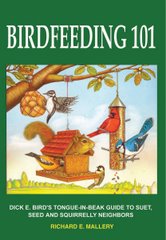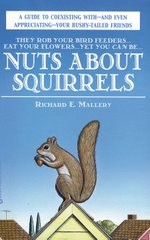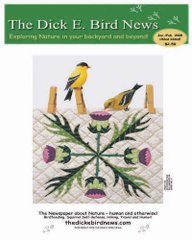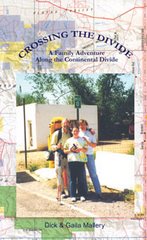
Constructive Construction Tips:
From Birdfeeding 101
One of the most widespread misconceptions in the birdhouse-building trades is the perch at the entrance door. Traditionally, perch sticks or rods have been placed at the entrance for a bird to land on prior to entering the nesting space. I have no idea whose idea this was originally, but it was a design that people made into a standard.
No matter how cute this looks, it is not necessary or advised. Think about it—cavity-nesting birds historically built their nests in vacated woodpecker holes and natural tree cavities. Have you ever seen a woodpecker hole with a 2-inch dowel rod at the door? Birds are very capable of entering a nesting box entrance hole without optional foothold designing.
That perch is nothing but an invitation for predators to sit comfortably and harass adults or eat the young nestlings or eggs. So the first rule of thumb when building a nesting box is leave the perch rod out of your design and off your masterpiece.
Building a nesting box is much more complicated than slapping together a few pieces of wood. Design function is much more important than design appearance. You need to build a nesting box for a particular species. To do this you need to know a few of the requirements each species expects to accept a nesting site.
Hole size is also very important. Again, I must stress that birds have never read the books and they often do not know how to act, but certain birds are attracted to certain size openings.
One of the most important aspects of caring for birds is cleaning up after them. This is true in feeding and housing them. For this reason it is very important that you incorporate in your nesting box design an opening that allows for cleaning out old nesting material and for observing nesting stages. In most cases a simple side opening using two axle nails will suffice. Also, a removable roof is often used. A design allowing a side or front to drop open makes much more sense. Using this method the box can be easily cleaned and the nest inspected. A nesting box wall that opens from the roof, or the side/front, opening up like a garage door, obscures the view and handicaps the cleaning approach to the box.
Predator-proofing a box is essential. Most successful nesting boxes have been given ample thought and testing for predator access. Any access door to the box must be securely fastened so a raccoon or other predator cannot pull it open. Most raccoons do not carry screwdrivers, so screwing the access door shut is the best method. Most predators will climb on top of a box and sit comfortably while they harass and try to reach the occupants. For this reason it is suggested you make that setting as uncomfortable as possible. Try using carpet tacking on the roof. Also, it is important to extend the reach to the targeted nest. You can do this using several methods. A wide roof is the most obvious. Many builders use a predator guard. This is a second piece of wood with a matching diameter hole that is attached directly over the nesting box entrance hole. This again extends the reach yet does not bother the birds as they enter and exit the box.
Some of the same methods used in feeder protection have been tried in the nesting box problem solving: greased poles, baffles, barbs and bullets. But the better method is good engineering. You will see in this chapter as we concentrate on certain species and designs that successful nesting box designers have considered all of the problems birds must face to pull off a brood or two each year and fine-tuned preventative measures to a point of almost guaranteed fledgings if followed.
Birds live outside so you would think they would be experts at handling foul weather, but that does not mean they wouldn’t be more successful if you took weather problems into account as you designed a nest box for them. High mortality is a way of life for birds. Nature designs it that way. Birds are a very important food source for many other critters. Weather takes more of a toll on birds each year than most people consider. When discussing a perfect nesting arrangement, weather must be a factor. The overhang we discussed to extend the predator reach also functions as a wind and rain guard. Good drainage and ventilation are important to keep adult birds and their young warm and dry and cool so they don’t fry. Place several drain holes in the bottom of nesting boxes and several ventilation holes near the side tops.
Weather is also a consideration when deciding the materials you will use to build the better birdhouse. Galvanized nails sound good but they easily loosen as wood expands and contracts. Screws and ring shank nails are a much better choice. Cedar is a popular choice of construction material. It is soft and easy to work with and is weather resistant. Using scrap material is a good idea but never use treated lumber. Birds that might choose to nest in a nesting box constructed of treated lumber are at risk of being poisoned by vapors produced when the material is exposed to the elements.
Insulation is an important part when providing shelter for birds. A thick-walled nesting box creates its own insulation factory. Using metal or thin plastic jug materials will attract birds and produce successful nests, but it is advised to place these units in shaded areas.
A rough surface should be created on the inside just below the opening of the nesting box to help fledglings exit when it’s time for flight lessons. Also, on the inside you can soap the ceiling. This will discourage wasps from taking over the box.
In the fall leave the box open and exposed. If you choose to leave nesting boxes closed up, you will invite many winter residents to take over the structure for the winter. Field mice and squirrels will take up residence, and then you have the job of evicting them in the spring when your birds are expected back. They do not often take this action lightly and will come back and destroy egg production. It is a much wiser management decision to just build your field mice and squirrels their own box and monitor them also.
When building nesting boxes always count your fingers before and after cutting material. You should have the exact same number when complete. --Keep Smilin', Dick E. Bird
















